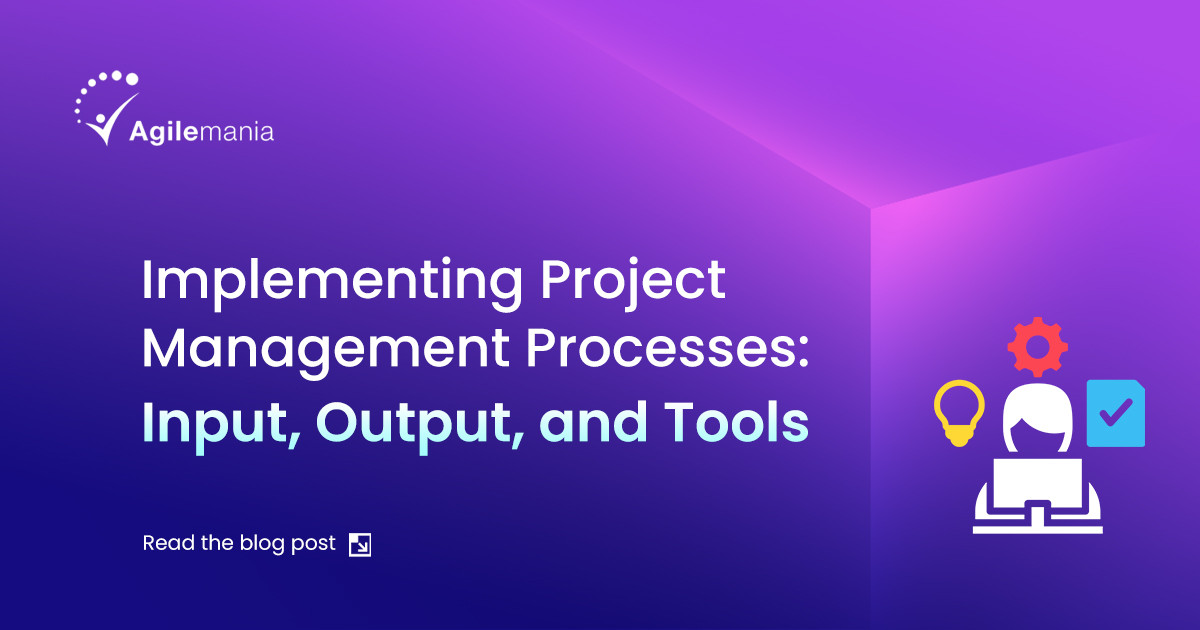
Satyajit Gantayat
Satyajit has broad and deep experience in Agile coaching at the strategic senior executive level wh... Read more
![]() Get Your AI-Enabled Scrum Master Certification for Just ₹1,500 (Save 85%)!
Get Your AI-Enabled Scrum Master Certification for Just ₹1,500 (Save 85%)!
Scrum.Org
SAFe®
ICAgile
Scrum Alliance
Technical Agility
Kanban
Business Analysis
Project Management
AI-Enabled
Agilemania Academy
Scrum.Org
SAFe®
ICAgile
Scrum Alliance
Technical Agility
Kanban
Business Analysis
Project Management
AI-Enabled

Satyajit Gantayat
Satyajit has broad and deep experience in Agile coaching at the strategic senior executive level wh... Read more

Imagine you are organizing an event. Let’s see how ITTO comes into play.
Inputs: Information such as the concert venue, budget, artist lineup, and expected audience size.
Tools and Techniques: To organize the event, you use project management software, scheduling tools, and meetings with vendors, along with your team’s expertise to book the stage, sound systems, and security.
Outputs: The final concert plan, which includes the concert schedule, confirmed bookings, vendor contracts, and assigned responsibilities for your team.
Now, what happens if any of the processes is missing?
Let's suppose you skip (input) the venue and budget details.
You might end up booking any space that is so small, or you will overspend on equipment.
Or
What if you skip using scheduling tools? You could miss crucial deadlines.
This could delay the event. People might get upset and never attend a concert you organize in the future.
The same happens in project management. If you skip any part of ITTO, you end up disrupting the entire project.
So, understanding and following each step in ITTO is very crucial. In this blog, we will discuss ITTO in detail. Let's begin
The complete form of ITTO is Input, Tools, Technology, and Output. This tool helps you find the resources needed to complete the task.
This helps better plan to create a better plan and execute the process. This tool can help reduce uncertainties and increase the likelihood of a successful outcome.
Inputs are the ingredients of the recipe, without which you cannot start cooking.
Just like you need flour, eggs, and sugar to bake a cake, in project management, you need resources like people, materials, and information.
Without these essential inputs, the process can't move forward. Some common inputs are necessary to pass the PMP exam.
Let’s discuss some crucial inputs for project management.
It is a crucial input document because it provides clear direction for the project and ensures that everyone understands its purpose and goals.
It acts as a foundation for all future project activities and decisions.
It is an official authorization document to begin the project.
This document has the project's objectives, key stakeholders, high-level requirements, and authorization of the project manager.
This document also contains the project, scope, budget timeline, etc.
The budget is the amount of money allocated to the project; it contains all the funds required to execute tasks, hire resources, and manage the project from start to end. Project managers ensure to stay within the budget and not overspend.
This document provides a clear understanding of what the project will achieve. It also prevents scope creep by defining what is included in the project and what is not included in the project.
With the scope statement, the project manager navigates their team to deliver the project within the timeframe.
Let’s suppose the company is developing a new application; the scope statement includes the entire details of the app, such as user login, profile creation, and messaging abilities.
It would also include the things that are not required, such as video calls, ensuring every team member is on the same page and should know the exact focus.
Stakeholders are the people who have shown interest in the project. It is essential to identify the stakeholders and engage them to make sure the project is aligned with needs and expectations.
This timeline shows when the project will begin and end. As a result, the project stays on track and meets its deadlines.
It’s a document associated with the risks the project will have and the strategies to resolve them. This helps the project manager to manage risk effectively.
Suppose you are managing a construction project. One of the identified risks would be delay due to bad weather. So, the risk register will record all the consequences of bad weather on the project and create a coping mechanism to deal with the particular issue.
Change requests often serve as input when managing changes during the project lifecycle. This could be changed to project scope, timelines, costs, or other essential elements.
For example, if a stakeholder wants to add a new feature to the product, that request is documented as a change request.
Various tools and techniques analyze this input to know the impact on the project and accordingly approve, reject, or defer the changes.
If approved, the output might involve updating the project plan, budget, or schedule.

The tools in ITTO can range from software application methodologies to systems that help manage many components of projects.
With the tools, the project manager and team can organize work, track tasks, manage resources, and ensure the smooth execution of project processes.
Let’s discuss some crucial tools for project management.
It is a computer program that helps project managers' team members to plan, execute, monitor, and control various project activities.
Let’s discuss some essential functions of project management software:
Scheduling tasks: Creating and managing deadlines for various tasks.
Allocation of resources: Assigning tasks and managing people effectively.
Project progress tracking: Monitoring task status and the progress of the project.
Collaboration: Boost communication among team members through chats, file sharing, etc.
Reporting: Generating reports on project performance, such as cost, schedule, and resource utilization.
Some popular project management tools are Microsoft Project, Trello, Jira, Asana, and Monday.com. These tools ensure the project process is well-organized, efficient, and aligned with the project goals.
This tool helps to identify and evaluate potential risks related to the project. This includes a risk register, matrix, and assessment to help project managers identify, prioritize, and mitigate the risk.
These software applications enable users to arrange and manage data in rows and columns. They are valuable tools for data analysis, report generation, and progress monitoring. Examples include the Responsibility and Assignment Matrix (RAM) and the probability and impact matrix.
These diagrams or visual representations of the data help in the analysis. Also, these visual diagrams help clarify complex information, illustrate relationships, and enhance collaboration among team members.
Common types of visuals used as tools in project management are Gantt charts, flowcharts, Kanban boards, dashboards, and mind maps.
Quality control is crucial for identifying defects and issues in the project outcome. It ensures that the output should align with the expectations of stakeholders.
Imagine a company producing smartphones. During production, the quality control team checks each phone to ensure the screen, battery, and other components function correctly.
If a phone fails to meet the set standards, it's sent for rework before being released to customers. This ensures only high-quality products reach the market.
Project managers can make informed decisions using tools and processes such as cost-benefit analysis or decision trees. To make informed decisions, they can help analyze data and consider different options.
These are the specific methods and approaches used to perform a specific task. Some of the most commonly used techniques are as follows;
This refers to meeting people and sharing ideas, suggestions, and solutions for a specific problem. The reason for this is to encourage creativity and gather a broad range of information without making any judgment or criticism during the process.
From this technique, the project manager prioritizes stakeholders based on their interests, expectations, and level of interest so that the project team can involve them during the entire project lifecycle.
This technique analyses strengths, weaknesses, opportunities, and threats related to the project. This technique is very useful when identifying the risk associated with the project.
For example, when we launch any software product, a project manager often uses SWOT analysis to:
A good development team identifies strengths.
Consider limitations in marketing resources as a weakness.
Spot opportunities like a growing market for similar software.
Address threats when a competitor launches a product.
By analyzing these factors, the project manager can develop strategies to leverage strengths, mitigate weaknesses, seize opportunities, and minimize the impact of threats.
This tool helps project managers identify and eliminate any risks associated with the project so project managers can take action accordingly.
Agile methodologies are important for executing agile frameworks like Scrum, kanban, and others, as agile methodologies focus on flexibility, collaboration, and customer feedback.
Let’s imagine you are developing a mobile application. You and your team are waiting for the entire app to be built and tested. By doing this, it will take a lot of time.
So, with the help of Agile, you can release and test a small feature every few weeks—like the login screen. If something needs improvement, you can adjust immediately, ensuring a better final product.

These are the results or deliverables that are produced after certain activities, processes, and tasks. Some of the most commonly used outputs are as follows;
A work breakdown structure has a structure like a tree. The main goal starts from the top and breaks down till the end. It breaks down the task into smaller and more manageable tasks. This way, the project manager can plan and coordinate the project goals.
What happens when your team stucks improving customer service?
Well, they gather and discuss everything openly, share ideas and brainstorm creative ways to solve problems.
So, this technique is about how the team works and shares their ideas to solve a specific problem.
As the name says, it is about the status of the project. Status reports are the documents that provide regular updates about the project, such as how much of a task has been completed. How far are we from the milestone? How much budget is left? What are the potential risks?
These reports help stakeholders be informed and make timely decisions to keep the project on track.
Suppose the client requests to add a feature to the software project.
The team added the feature, which now affects the budget and time. The project team approves the change.
Now, it has become an “approved change.” Then, these changes are added to the project plan and execution.
Whenever you take an exam and fail and then have another attempt, what do you do?
You analyze the mistakes you made in the previous exam and learn from them to avoid repeating the same errors.
The same applies to lessons learned in project management. These are the valuable insights a team gains during a project—what went wrong and what went well.
Documenting lessons learned helps correct past mistakes and reinforces successful strategies for future projects.
Suppose you and your team have developed a new mobile app. The final report would include:
An overview of the project goals (e.g., creating a user-friendly app).
A comparison of planned vs. actual timelines (e.g., expected six months but completed in 7 months).
Budget details (e.g., finished under budget or exceeded it).
Outcomes (e.g., app features delivered).
Lessons learned (e.g., challenges with user testing).
The final report acts as a closure document so that the stakeholders have a complete understanding of the project results.
It refers to the final product or result of all project activities
It states that whatever the team had planned, delivered, and objectives had been done, and the project was now officially closed.
This output is conducted by a formal project closure process, which includes recording the last outcomes, obtaining stakeholder approval, and releasing project resources.
For example, if the government decides to build a park for children to play in, once the playground is completed, including all installations like swings, slides, and benches, the completed project output is a fully functional playground that the community can enjoy.
At this stage, the team would conduct a final inspection, gather feedback from the community, and ensure that all project goals have been met before closing the project.
All in all, learning ITTOs is essential when it comes to successfully implementing project management in its various certifications, such as the PMP exam.
It is crucial to the project management process when specific Inputs, Tools, Techniques, and Outputs are well understood.
There are ways in which the projects can be handled in a more cohesive manner, which will enhance the probability of success in the endeavor.
It is also important to note that project management does not entail just implementing rules.
Instead, these rules offer a basis for analysis, the resolution of issues, and the accomplishment of projects.
Make sure that you concentrate on understanding these concepts, as you will stand a better chance of completing any projects presented to you.
Enroll now in our PMP Certification Training and take the first step toward becoming a certified project management professional!
Enroll Now!
Regularly review inputs and outputs throughout the project to ensure alignment with goals and make necessary adjustments as challenges arise.
By providing structured steps, clear inputs, and defined outputs, project management processes help teams stay organized and focused on timely delivery.
Study the PMBOK guide, practice with sample questions, and review real-life project scenarios to understand how inputs, outputs, and tools are applied in practice.
Common challenges include unclear requirements, lack of stakeholder involvement, and insufficient resource availability, which can hinder project success.
Satyajit has broad and deep experience in Agile coaching at the strategic senior executive level while also coaching and uplifting the capability of teams and individuals. An Agile Coach and SAFe® Practice Consultant with more than 24 years of experience.
WhatsApp Us

We will get back to you soon!
For a detailed enquiry, please write to us at connect@agilemania.com

